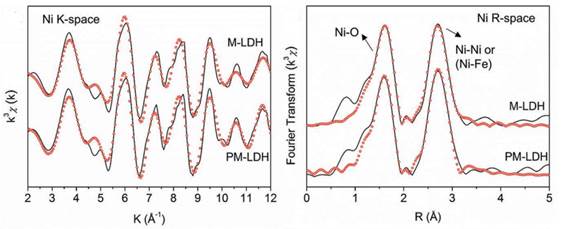| Defect-Rich Porous Monolayer NiFe-Layered Double Hydroxide Nanosheets for Efficient Electrocatalytic Water Oxidation |
| From: PublishDate:2020-07-30 Hits: |
The demand for renewable energy is growing rapidly due to human population growth, depletion of fossil fuel energy resources, and environmental pressures. Efficient and low-cost electricity generation and electricity storage technologies are needed before we can realistically shift away from fossil fuel energy. The oxygen evolution reaction (OER) will be a potential strategy in future electricity storage, being a key process in electrocatalytic water splitting and rechargeable metal-air battery systems. However, the efficiency of OER over most electrocatalyst systems developed to date are low and limited by the slow kinetics of the OER process. Therefore, it is of great significance to develop electrocatalysts with high-efficiency OER capabilities. Recently, two-dimensional layered nickel-iron layered double hydroxides (NiFe-LDH) is considered to be one of the most potential OER catalysts to replace traditional IrO2 and RuO2 precious metal electrocatalysts. However, the poor conductivity and low exposed active sites of 2D NiFe-LDH inhibit its further development in electrocatalysis. Accordingly, the discovery and development of efficient 2D catalysts for OER based on earth-abundant elements, especially first row transition metals, is highly desirable. Recently, Zhang’s group reported a simple, one-step synthetic strategy toward defect-rich porous monolayer NiFe-LDH (denoted as PM-LDH) with the outstanding OER performance. Their research has been published on May 10th, 2019 in Adv. Energy Mater.
The detailed study of the coordination environment of Ni and Fe atoms in defect-rich porous monolayer NiFe-LDH and monolayer NiFe-LDH using XAFS technique carried out at 1W1B-XAFS station of BSRF. “In this work, we reported the discovery of a simple, one-step synthetic strategy toward PM-LDH with a lateral size of ~30 nm and thickness of ~0.8 nm.” said by Tierui Zhang, the team leader and the professor of Key Laboratory of Photochemical Conversion and Optoelectronic Materials, Technical Institute of Physics and Chemistry. The PM-LDH showed excellent OER performance with a low overpotential of 230 mV at a current density of 10 mA cm-2, and a Tafel slope of 47 mV dec-1 (the activity represents one of the best OER performance yet reported for a NiFe-LDH system). High-angle annular dark-field scanning transmission electron microscopy, electron spin resonance and extended X-ray absorption fine structure measurements confirmed the existence of multivacancies (oxygen vacancies and metal vacancies) in PM-LDH. The oxygen and metal vacancies in PM-LDH act synergistically to increase the conductivity of the LDH nanosheets, while also enhancing H2O adsorption and bonding strength of the OH* intermediate formed during water electrooxidation, endowing PM-LDH with outstanding performance for OER. The results encourage the wider utilization of porous monolayer LDH nanosheets in electrocatalysis, catalysis, and solar cells. Article: Xin Zhang,# Yufei Zhao,# Yunxuan Zhao, Run Shi, Geoffrey I. N. Waterhouse, Tierui Zhang* A Simple Synthetic Strategy toward Defect‐Rich Porous Monolayer NiFe‐Layered Double Hydroxide Nanosheets for Efficient Electrocatalytic Water Oxidation. Adv. Energy Mater. 2019, 9, 1900881. |
|
|
| Chinese
- Metal-free efficient photocatalyst for stable visible water splitting——Top ten major scientific progresses in China in 2015
- The nano-resolution imaging platform was awarded the first rate prize of Beijing Science and Technology in 2014
- Beamline 1W1 of BSRF started to runoperate in the couplingparasitic mode of BEPCII
- Synthesis of High Performance Polymer Materials for Field Effect-Transistors
- Surfactant molecular aggregates in green solvents
- GIXRD has played an important role in the characterization of organic thin-film transistors
Science Highlights
Home /
Copyright © 2011 - 2012 Beijing Synchrotron Radiation Facility



